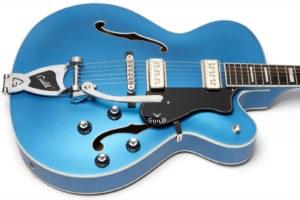 Today’s Guild is a Newark St. X175 Manhattan Special from 2020, and I gotta say that as soon as I saw this guitar announced I knew that I had to have one. From the killer blue finish to the DeArmond pickups, this guitar looks like everything I’d ever want in a guitar. Is it? Read along while I take a look at this gorgeous Malibu Blue Newark St. Guild guitar right down to my comments about the ground wire leading to the tailpiece. And yes, I have comments about that wire.
Today’s Guild is a Newark St. X175 Manhattan Special from 2020, and I gotta say that as soon as I saw this guitar announced I knew that I had to have one. From the killer blue finish to the DeArmond pickups, this guitar looks like everything I’d ever want in a guitar. Is it? Read along while I take a look at this gorgeous Malibu Blue Newark St. Guild guitar right down to my comments about the ground wire leading to the tailpiece. And yes, I have comments about that wire.
Introduction
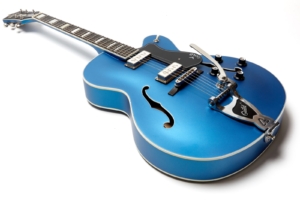 Announced at 2020 NAMM, the X175 Manhattan Special along with the X350 Straford stole the show, mostly due to the beautiful blue and red finishes on the guitars, with honorable mention going to the Starfire I SC in SeaFoam Green that I reviewed here. While the Starfire Is are made in Indonesia, the X175 Manhattan Special is made in Korea, which arguably makes it one of the higher-quality guitars in the current Guild Newark St. lineup.
Announced at 2020 NAMM, the X175 Manhattan Special along with the X350 Straford stole the show, mostly due to the beautiful blue and red finishes on the guitars, with honorable mention going to the Starfire I SC in SeaFoam Green that I reviewed here. While the Starfire Is are made in Indonesia, the X175 Manhattan Special is made in Korea, which arguably makes it one of the higher-quality guitars in the current Guild Newark St. lineup.
Unfortunately there isn’t a catalog that I can show you because Guild hasn’t distributed a catalog this year, possibly due to the whole Covid-19 mess. As a catalog junkie that makes me sad, but such is life here in the future.
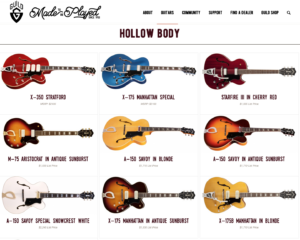 According to the Guild website (June 2020) the X175 Manhattan Special and the X350 Stratfords both share the honor of being the second highest-priced guitars in the Newark St. line, with both having an MSRP of $2100. What wins first place? The A150 Savoy Special in Snowcrest White. Why is that guitar $140 more expensive even though it seems to be less complicated? My guess is the fact that the specs list it as having gold-plated hardware and mother-of-pearl inlays where the obviously similar A150 Savoy in blonde has silver hardware and pearloid inlays for a whopping $500 less, but we’re not here to talk about Savoys; we’re here to talk about big blue Manhattan Specials!
According to the Guild website (June 2020) the X175 Manhattan Special and the X350 Stratfords both share the honor of being the second highest-priced guitars in the Newark St. line, with both having an MSRP of $2100. What wins first place? The A150 Savoy Special in Snowcrest White. Why is that guitar $140 more expensive even though it seems to be less complicated? My guess is the fact that the specs list it as having gold-plated hardware and mother-of-pearl inlays where the obviously similar A150 Savoy in blonde has silver hardware and pearloid inlays for a whopping $500 less, but we’re not here to talk about Savoys; we’re here to talk about big blue Manhattan Specials!
The X175 Manhattan model is one of the earliest Guild electric guitars and appears in the 1954 catalog as shown here. Back then the guitar was a bit different with its master volume and tone, it’s Franz pickups, and very ’50s-looking knobs, not to mention the obviously different M175 moniker. The guitar would evolve a bit as time went on, but the basic shape of the instrument with its Venetian cutaway would remain basically unchanged over the years, and you can see the clear similarity in the shape of this guitar to the one in the catalog from 66 years ago.
The X175 (or really any Guild) doesn’t seem to show up in the catalogs with DeArmond pickups, but according to The Guild Guitar Book by Hans Moust, the DeArmond 2000 pickups were outfitted on the Starfire line starting in 1961 and became available on other hollowbody models soon thereafter. Indeed, there are many excellent photographs of beautiful vintage Guilds with DeArmond 2000 pickups in that book, but I have been unable to find any with the iconic pickups in an X175. That in no way means that none exist, but rather just that my ability to find one exceeded my attention span. You can read more about the history of the X175 model in this review of my 1983 X175.
Historical accuracy has never been a requirement in Newark St. Guilds, and so the appearance of reissued DeArmond pickups (more on that later) should not in any way be considered a problem for this beautiful blue guitar. In fact, I think these pickups are a perfect fit on this model, especially when you consider the color scheme which is clearly blue, white, and black. More on that later, too.
I’ve seen people ask if this guitar is similar to the old US-made X160 Rockabilly, and looking at the pictures it’s easy to see why people might think that, so let’s look at the differences:
X160 Rockabilly
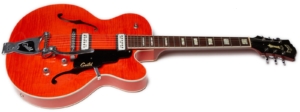 US Made (Westerly and Corona)
US Made (Westerly and Corona)- DeArmond 2000 or 2K pickups (depending on year)
- Flame maple top, back, and sides
- Mahogany 3-piece neck
- Finish in Tennessee Orange, Metallic Blue, Black, and Fiesta Red
- 16 ¾” lower bout (Westerly)
- 15 7/8″ lower bout (Corona)
- 3 ½” depth (Westerly)
- 3″ depth (Corona)
- Master Volume/Tone
- Rocking Bigsby bridge (not shown on this one)
- Impossible to replace stair-step pick guard
Newark St. X175 Manhattan Special
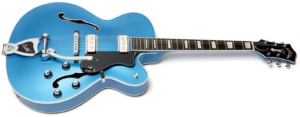 Made in Korea
Made in Korea- Korean copy of 2000s era DeArmond 2k pickup (not the original 1950s model)
- Spruce top
- Mahogany with maple center strip
- Only comes in satin Malibu Blue
- 17″ lower bout
- 3″ depth
- Individual Volume/Tone controls
- Tune-O-Matic bridge
- Standard Newark St. hollow-body pick guard
Additionally the X160 Rockabilly has better tuners, better electronics, better hardware, a more robust finish, and a very different feel and sound due to the construction of the guitar. They also sell in the $2000 USD range used and are very hard to come by, so for right now this is probably as close as you’re likely to get in a new Guild. It is also in no way being sold as a replacement for the X160 Rockabilly; I just figured I’d address the question since I’ve seen so many, and honestly – I totally get why!
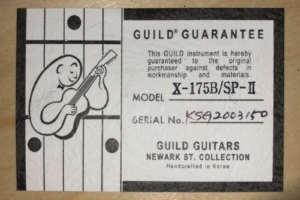 Looking at the webpage for this guitar, I wondered why it’s called an X175 Manhattan Special and not an X175B Manhattan Special when the guitar it’s based on is an X175B Manhattan. I’m going to go out on a limb and say because Marketing likes it that way. You see, inside the guitar on the label, the model number is listed as X-175B/SP-II which makes more sense, based on the design, but then it raised another question for me: If this is the X-175B/SP-II, where’s the SP-I? Then something sort of klanged in my head and I had a thought. What if…
Looking at the webpage for this guitar, I wondered why it’s called an X175 Manhattan Special and not an X175B Manhattan Special when the guitar it’s based on is an X175B Manhattan. I’m going to go out on a limb and say because Marketing likes it that way. You see, inside the guitar on the label, the model number is listed as X-175B/SP-II which makes more sense, based on the design, but then it raised another question for me: If this is the X-175B/SP-II, where’s the SP-I? Then something sort of klanged in my head and I had a thought. What if…
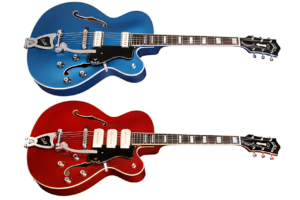 Look at the pic here of the new Guild X175 Manhattan Special along with the also new X350 Stratford and tell me they’re not the same guitar but with an obviously different pickup layout. Zooming into the photo even the white psuedo-binding on the f-holes looks the same! Now I need to know what it says on the label of the Newark St. X350! None of the stores around me have one so time will tell if I’m crazy enough to buy one online just so I can read the label. If you’ve got one please post a comment!
Look at the pic here of the new Guild X175 Manhattan Special along with the also new X350 Stratford and tell me they’re not the same guitar but with an obviously different pickup layout. Zooming into the photo even the white psuedo-binding on the f-holes looks the same! Now I need to know what it says on the label of the Newark St. X350! None of the stores around me have one so time will tell if I’m crazy enough to buy one online just so I can read the label. If you’ve got one please post a comment!
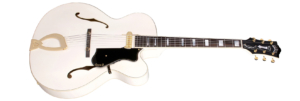
Then again, the Guild Newark St. A150 looks like it shares the same superstructure, too. Maybe some enterprising person at Guild found a clever way to refinish white guitars that had failed QC in such a way as to make them even better than the originals! That’s definitely the kind of thing that happens in large production lines whether it be guitars or restaurants, so that’s not a knock on Guild at all. I just like to try and figure out how things work which, as it turns out, I have not accomplished in the slightest.
The case
This guitar comes with a Guild Deluxe Wood Case case, and I have to say that the case is pretty nice! It’s also enormous to properly protect the deep-bodied X175 Manhattan. It doesn’t hurt the overall aesthetic of the guitar when you open the case and see the beautiful blue instrument nestled into the nice blue lining of the case, either.
Aside from the a cool new Guild badge on the case there’s nothing out of the ordinary about it, but I felt the need to mention that it seems robust enough to last a while.
Finish
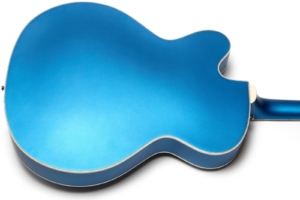 If there’s anything that catches your eye about this guitar it’s the finish. The finish is called satin Malibu Blue and it’s fairly striking. The matte nature of the finish is what accounts for the lack of reflections on the body, and let me tell you: as someone who battles reflections constantly, this guitar was an absolute joy to photograph.
If there’s anything that catches your eye about this guitar it’s the finish. The finish is called satin Malibu Blue and it’s fairly striking. The matte nature of the finish is what accounts for the lack of reflections on the body, and let me tell you: as someone who battles reflections constantly, this guitar was an absolute joy to photograph.
The finish is gorgeous, but I worry that it won’t hold up well to abuse. In order to explain why, let me first reveal an important detail about this specific guitar with the caveat that I could be completely wrong.
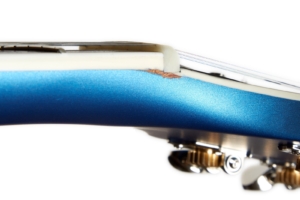 This guitar came to me via an Ebay sale where Cordoba Music Group sold it as a factory second due to an issue with the finish as seen in this picture. It is not fair to judge this guitar by this blemish at all because this blemish made the guitar a factory second and I was perfectly happy to pay the lower price due to the guitar being imperfect. I set out to write this review completely ignoring the finish blem and was content to do so. I can’t feel or see it while playing and it’s purely cosmetic in that it does not affect the playability or sound of the guitar at all.
This guitar came to me via an Ebay sale where Cordoba Music Group sold it as a factory second due to an issue with the finish as seen in this picture. It is not fair to judge this guitar by this blemish at all because this blemish made the guitar a factory second and I was perfectly happy to pay the lower price due to the guitar being imperfect. I set out to write this review completely ignoring the finish blem and was content to do so. I can’t feel or see it while playing and it’s purely cosmetic in that it does not affect the playability or sound of the guitar at all.
However…
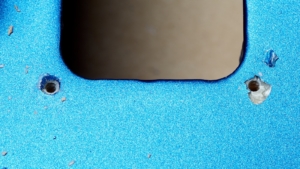 Every time I turned a screw to remove a part, little bits of the finish flaked away. By the time I had removed the eight screws that attach the pickups to the guitar, the top of the guitar was covered with flakes of blue, some of which you can see in this picture. To be fair, this may not be a problem for the average user who never removes their pickups, so I made a note of it and moved on. Actually, as I was putting the guitar back together I noticed that it was not every screw hole that exhibited this behavior. All three of the screw holes for the pick guard were just fine, which leads me to wonder if this is happening here because the guitar is very curved on the top or maybe someone just over-tightened the pickup screws.
Every time I turned a screw to remove a part, little bits of the finish flaked away. By the time I had removed the eight screws that attach the pickups to the guitar, the top of the guitar was covered with flakes of blue, some of which you can see in this picture. To be fair, this may not be a problem for the average user who never removes their pickups, so I made a note of it and moved on. Actually, as I was putting the guitar back together I noticed that it was not every screw hole that exhibited this behavior. All three of the screw holes for the pick guard were just fine, which leads me to wonder if this is happening here because the guitar is very curved on the top or maybe someone just over-tightened the pickup screws.
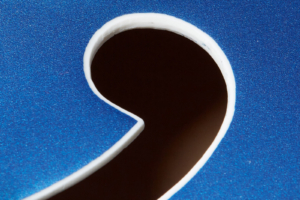 At first sight the guitar seems quite luxurious with its bound f-holes, but I realized that they look kind of strange. Some macro photography showed me that the f-holes are not bound at all! Looking at a bunch of the photos, I noticed that it seem the white that’s showing on the rim of the f-holes is actually some sort of base-coat and it looks like the edge of the wood was taped off while the blue finish was sprayed.
At first sight the guitar seems quite luxurious with its bound f-holes, but I realized that they look kind of strange. Some macro photography showed me that the f-holes are not bound at all! Looking at a bunch of the photos, I noticed that it seem the white that’s showing on the rim of the f-holes is actually some sort of base-coat and it looks like the edge of the wood was taped off while the blue finish was sprayed.
Indeed, looking at the previous photo of the screw holes for the pickups, it looks like there is a white undercoat evident there as well. I think this is a clever way to get the bound f-hole look of a high-end guitar without the skill and labor necessary to accomplish such an upgrade, but given the finish’s possible proclivity for flaking, I fear that the f-holes may end up with some ugly wear patterns over time. Again I need to point out that this is pure speculation and the only place I found issues was where screw holes had been drilled through the finish.
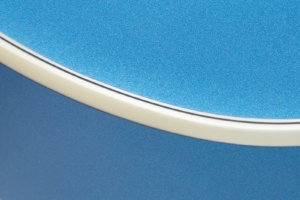 In fact, if you look closely at the binding on the guitar, you can see that the finish sits a bit higher than the binding, again giving the impression that it was sprayed on with tape covering the binding that was layer removed. This is not an optical illusion; you can feel the ridge of the finish on the binding. I’d bet that you could pick at it with your fingernail, though I’d advise against that on any instrument.
In fact, if you look closely at the binding on the guitar, you can see that the finish sits a bit higher than the binding, again giving the impression that it was sprayed on with tape covering the binding that was layer removed. This is not an optical illusion; you can feel the ridge of the finish on the binding. I’d bet that you could pick at it with your fingernail, though I’d advise against that on any instrument.
I should point out that aside from the screw holes, I have not had a problem with the finish. My concern is that I might, but until a year’s worth of data comes in from people gigging with these things, the jury is, and will remain, out for the duration. The guitar’s finish is freaking beautiful and I absolutely love the way it looks. It is my fervent hope that the guitar remains freaking beautiful forever.
Fretboard and Neck
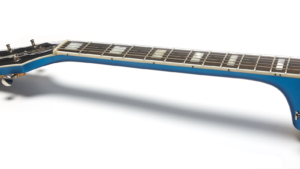 The scale length of this guitar is 24 ¾”, and the neck is mahogany with a maple center strip according to the specs. The fretboard is bound ebony and while it doesn’t have the ultra-black luster of a vintage ebony slab, it looks and feels fabulous with grain streaks really only showing up at very close examination. The white binding looks great on the guitar as the color scheme is blue, black, and white and the binding really helps to make that contrast pop.
The scale length of this guitar is 24 ¾”, and the neck is mahogany with a maple center strip according to the specs. The fretboard is bound ebony and while it doesn’t have the ultra-black luster of a vintage ebony slab, it looks and feels fabulous with grain streaks really only showing up at very close examination. The white binding looks great on the guitar as the color scheme is blue, black, and white and the binding really helps to make that contrast pop.
The specs say that this guitar has a Vintage Soft “U” shape, but I just don’t feel that which is why it says “C” in my notes. That’s not to say that the specs are wrong by any means, but for me a U-shaped neck has definite shoulders and I just don’t feel them on this guitar, so let’s just agree that I’m a cantankerous old fool and move on.
The frets measure .09″ wide by .06″ high making them narrow jumbos. I like the frets but I can see why people used to vintage wide and flat frets might not. To those people I advise that you learn to play with a lighter touch and then you won’t pull the strings out of tune on guitars with higher frets. Hey, if I did it then so can you. The fretwork is very nice and so consistent that I have to imagine that it was done on a machine. If not, then good job to the fret dresser!
The inlays are very nice with a lot of character, with a very pearlescent look which really works quite well on this guitar, again because of the color scheme.
The width at the nut is a solid 1 11/16″ and the neck is .83″ deep at the first fret, making this a very comfortable neck in my large hands. The fretboard radius is 9.5″ which matches the bridge perfectly.
Build Quality
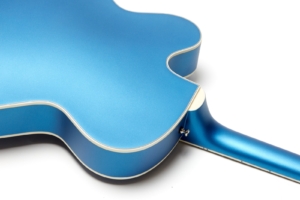 I was honestly surprised to discover that the guitar was fully hollow. I mean, Guild advertises it as such, but I expected there to be a sound post of some type and there is not. This guitar feels very well put together, and I found absolutely nothing to complain about, and I did my best to find something since, as my wife will tell you, I love to complain.
I was honestly surprised to discover that the guitar was fully hollow. I mean, Guild advertises it as such, but I expected there to be a sound post of some type and there is not. This guitar feels very well put together, and I found absolutely nothing to complain about, and I did my best to find something since, as my wife will tell you, I love to complain.
The body is bound on the front and back and the black/white binding looks fabulous, again adding to the black/blue/white color scheme that looks so great.
My guitar weighs in at exactly 7.0 pounds (3.18 kg) so it weighs a bit less than my 1994 X170 (that has a sound post) and a full pound or even two pounds lighter than the vintage X500s I reviewed. The top is spruce and there are two braces that run lengthwise from the neck block to the end block just on the outside of the pickup route which is pretty standard for a fully hollow-bodied guitar.
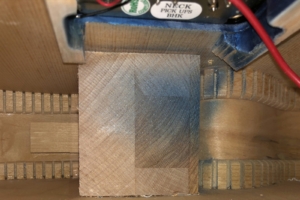 Internally the guitar appears to be well made, and while it doesn’t look like the inside of a hand-made custom shop guitar, it wasn’t billed as one. While no one in their right mind would complain about (or even notice) the blue overspray inside the guitar (Red Alert! A Flaw!), it’s one of those things that you don’t see in master-built instruments, either. Structurally, though, I didn’t see anything to worry about. I found it a bit odd that the neck block seems to be comprised of five or more pieces of wood, but the average buyer doesn’t buy a guitar for the design aesthetic of the neck block. Actually, I don’t know that anyone would do that.
Internally the guitar appears to be well made, and while it doesn’t look like the inside of a hand-made custom shop guitar, it wasn’t billed as one. While no one in their right mind would complain about (or even notice) the blue overspray inside the guitar (Red Alert! A Flaw!), it’s one of those things that you don’t see in master-built instruments, either. Structurally, though, I didn’t see anything to worry about. I found it a bit odd that the neck block seems to be comprised of five or more pieces of wood, but the average buyer doesn’t buy a guitar for the design aesthetic of the neck block. Actually, I don’t know that anyone would do that.
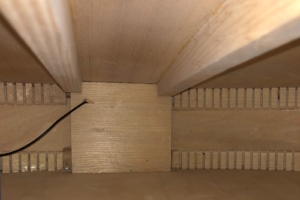 Looking the other way inside the body, you can plainly see the two top braces extending down to the end block. See that black wire? I promised that I would talk about that black wire, and I will do so in the Electronics section below.
Looking the other way inside the body, you can plainly see the two top braces extending down to the end block. See that black wire? I promised that I would talk about that black wire, and I will do so in the Electronics section below.
As a “Westerly Guilds are Best!” snob, the juvenile petty part of my brain desperately wanted to find something to complain about in the build quality, but I just don’t see anything to sound the alarm about. This is a well-made guitar that rocks the house and has a little bit of blue paint inside. Stand down from Red Alert.
Pickups
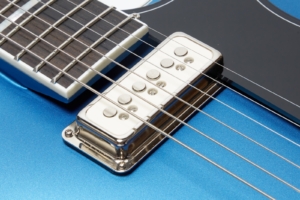 The Guild webpage calls the pickups in this guitar authentic DeArmond Dynasonic neck and bridge pickups which makes me laugh. Why? Allow me to pull you down into the rabbit hole.
The Guild webpage calls the pickups in this guitar authentic DeArmond Dynasonic neck and bridge pickups which makes me laugh. Why? Allow me to pull you down into the rabbit hole.
These are Korean copies of earlier copies of the authentic DeArmond 2000 pickups made in the 1950s. Why aren’t they Dynasonics? Because Dynasonic was a Gretsch marketing name for their version of the DeArmond 2000. Dynasonic is not a DeArmond name, and when I see the word Dynasonic I expect to see black covers because Gretsch DeArmond 2000s had black covers while Guild DeArmond 2000s had white.
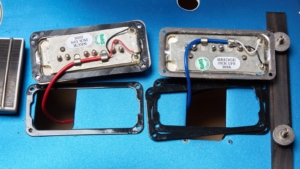 The pickups in this guitar are made in Korea as evidenced by the stickers on the back that show BHK with BHK being the abbreviation for BooHeung Precision Machinery in Korea. This is where the Newark St. HB1 and LB1 pickups are made along with pickups for most other import guitars from the likes of Gretsch, Epiphone, and Squier. But they’re remakes of the iconic DeArmond pickups from the ’50s, right? Well, not exactly.
The pickups in this guitar are made in Korea as evidenced by the stickers on the back that show BHK with BHK being the abbreviation for BooHeung Precision Machinery in Korea. This is where the Newark St. HB1 and LB1 pickups are made along with pickups for most other import guitars from the likes of Gretsch, Epiphone, and Squier. But they’re remakes of the iconic DeArmond pickups from the ’50s, right? Well, not exactly.
If you’d like a detailed read about the history of Guild and its reissued DeArmond pickups, check out my article on the subject entitled, Identifying DeArmond 200, 2000, and 2K Pickups which I will likely update with information about these pickups.
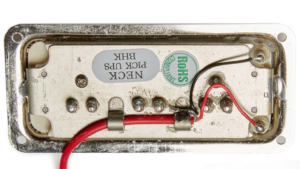 Here I have a picture of the bridge pickup from this guitar on a white background, flipped so that it matches the following photo which came from my Identifying DeArmond pickups article. In order to identify which pickup was used in the recreation, let’s look at the way the parts are laid out. Specifically the orientation of the pole pieces when compared to the two screws that hold the coil to the base.
Here I have a picture of the bridge pickup from this guitar on a white background, flipped so that it matches the following photo which came from my Identifying DeArmond pickups article. In order to identify which pickup was used in the recreation, let’s look at the way the parts are laid out. Specifically the orientation of the pole pieces when compared to the two screws that hold the coil to the base.
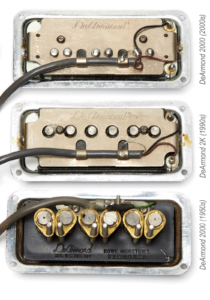
Now let’s look at this image showing three DeArmond pickups. From top to bottom they are, a Guild reissue DeArmond 2000 from the early 2000s, a Guild reissue DeArmond 2K from the 1990s, and finally an original DeArmond 2000 from the 1950s. Looking at the pickup from this Newark St. Guild, it’s quite obvious that this is a remake of the top one which is the DeArmond 2000 from the early 2000s which is already a remake of the original DeArmond 2000 from the 1950s! Confused by all the stupid names? I can’t imagine why. The closest match is to the top one which was made in the early 2000s, and not to the original vintage one on the bottom which was made in the 1950s. That may not be such a bad thing, though.
While a remake of the originals would have been very cool, of the two Remakes that Guild used in the 1990s and 2000s, the one from the 2000s sounds and behaves more like the original while the 2K from the 1990s sounds and behaves more like a Gibson P90 pickup. These DeArmond 2000 pickups from the early 2000s (yes, I know that’s confusing) are what’s in my X160 Rockabilly, and it does OK, though if I had to complain about the pickups in this Newark St. X175 Manhattan Special, I’d say they’re missing some of the [pick from list: balls, grunt, oomph, hutzpah, magic, mojo] that the originals seem to have. From what I’ve read others felt the same way about the X160 Rockabilly which may add credence to the idea that these pickups are copies of those 2000s from the 2000s.
None of that makes these bad pickups, but I felt the need (as I often do) to set the record straight after reading the authentic DeArmond Dynasonic neck and bridge pickups nonsense. Hell, I could argue that these “authentic” DeArmond pickups are copies of copies of copies of the originals, but I won’t. For now.
Electronics
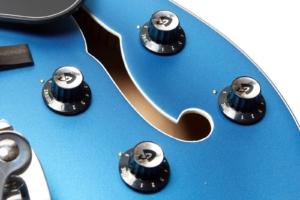 This is an X175 model, and as such it uses the same wiring harness as the regular X175 and X175B. I actually pulled the harness to validate that fact, so you owe me a beer if we ever meet. Actually I don’t drink beer, so maybe a nice Coke. A Mexican Coke in a glass bottle with real cane sugar, thank you very much. Did you really expect anything less specific from me?
This is an X175 model, and as such it uses the same wiring harness as the regular X175 and X175B. I actually pulled the harness to validate that fact, so you owe me a beer if we ever meet. Actually I don’t drink beer, so maybe a nice Coke. A Mexican Coke in a glass bottle with real cane sugar, thank you very much. Did you really expect anything less specific from me?
The controls for the guitar are the 1-9 knobs commonly seen on Newark St. Guilds, but the cool thing is that the guitar uses the little metal marker studs that are probably nothing more than escutcheon pins. I love these markers because they add a subtle bit of elegance and make the guitar feel like a Guild.
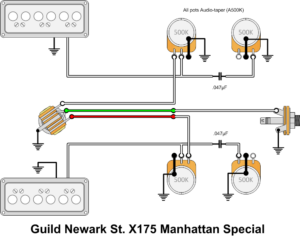 The great part about the guitar using the same harness as the X175 and the M75 Aristocrat is the fact that I’ve already reviewed at least one of those so I didn’t need to draw the schematic from scratch. Guild’s well thought out scheme of making wiring harnesses usable across multiple models is a great thing for people like me who document the guitars, though so far as I can tell there’s no one out there crazy enough to go to the lengths that I do when looking at a guitar.
The great part about the guitar using the same harness as the X175 and the M75 Aristocrat is the fact that I’ve already reviewed at least one of those so I didn’t need to draw the schematic from scratch. Guild’s well thought out scheme of making wiring harnesses usable across multiple models is a great thing for people like me who document the guitars, though so far as I can tell there’s no one out there crazy enough to go to the lengths that I do when looking at a guitar.
At any rate, I have no complaints with the electronics, especially after working with the mess that I found in that Starfire I SC. Oh wait – I almost forgot about the black wire!
 Remember that black wire from the Build Quality section? The black wire is the ground wire that connects the tailpiece to the ground circuit so that human contact with the guitar is a good thing. That ground wire is soldered to the output jack, and the output jack is then connected to the wiring harness so that the ground circuit is complete to all electronics in the guitar. The problem is that the black wire is just long enough so that I could get the wiring harness out of the guitar – but not the output jack!
Remember that black wire from the Build Quality section? The black wire is the ground wire that connects the tailpiece to the ground circuit so that human contact with the guitar is a good thing. That ground wire is soldered to the output jack, and the output jack is then connected to the wiring harness so that the ground circuit is complete to all electronics in the guitar. The problem is that the black wire is just long enough so that I could get the wiring harness out of the guitar – but not the output jack!
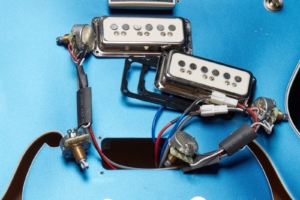 Thanks to the ground wire being so short, I couldn’t even get the output jack to be visible in the f-hole, and when I went to examine the harness, this was as far as I could get it to come out from the guitar. Normally I like to take a nice shot like this one from my 1997 Starfire III, and sometimes that’s not possible, such as on my 1983 X175, but I could still get all the components out to work on.
Thanks to the ground wire being so short, I couldn’t even get the output jack to be visible in the f-hole, and when I went to examine the harness, this was as far as I could get it to come out from the guitar. Normally I like to take a nice shot like this one from my 1997 Starfire III, and sometimes that’s not possible, such as on my 1983 X175, but I could still get all the components out to work on.
On this guitar there is no way to get to the output jack for replacement. I have to assume that the electronics were added before the guitar was completely assembled, but that doesn’t seem right since it was clearly finished with the top on (see previous overspray picture). It could be that it was wired up and then too much excess was removed when the tailpiece was installed. I don’t know, but it’s one of those things that no one would care about until the output jack needs to be replaced.
To be fair, the black wire could likely be removed by removing the tailpiece, pulling the jack and ground wire out, threading a longer new ground wire in, and then reassembling it all. To be doubly fair, this may well not be an issue with this model but with all the Newark St. hollow-body guitars. Looking back at my own notes, I did not pull the harness for my Newark St. Starfire III or X175B (no doubt due to being smarter than I am now), so this could just be an odd part of the Guild design for these guitars.
Hardware
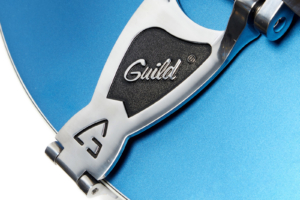 The hardware on this guitar is pretty standard fare for a Korean Newark St. Guild. The Guild-emblazoned Bigsby or Guildsby as we in the Guild community like to call it, looks great and functions as it should.
The hardware on this guitar is pretty standard fare for a Korean Newark St. Guild. The Guild-emblazoned Bigsby or Guildsby as we in the Guild community like to call it, looks great and functions as it should.
I may be dense (may be?) but I just noticed that the Guild logo on the Guildsby is different than it used to be. Not only does it now include the Registered Trademark symbol (®), but the font is a bit thinner and, I don’t know… sexier? Maybe? Also I may not have been sleeping well… At any rate, here’s a Westerly Guildsby from my X160 Rockabilly to compare it to.
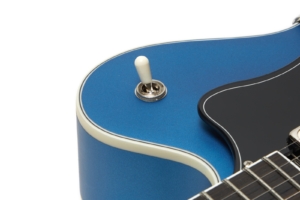 I feel the need to point out a delightful departure from other Guild Newark St. guitars, and that is the inclusion of a white switch tip. Sure, it’s just a dumb piece of easily replaceable plastic, but I really dislike the yellow ones on the other models, and this brilliant white gem perfectly matches the binding and other highlights on the guitar. Using the standard yellow one that comes with the harness would have been a horrible choice, so kudos to whoever pushed for there to be a white switch tip on this beautiful guitar, because it really works for me and it was literally the first thing I noticed about the guitar when I opened the case.
I feel the need to point out a delightful departure from other Guild Newark St. guitars, and that is the inclusion of a white switch tip. Sure, it’s just a dumb piece of easily replaceable plastic, but I really dislike the yellow ones on the other models, and this brilliant white gem perfectly matches the binding and other highlights on the guitar. Using the standard yellow one that comes with the harness would have been a horrible choice, so kudos to whoever pushed for there to be a white switch tip on this beautiful guitar, because it really works for me and it was literally the first thing I noticed about the guitar when I opened the case.
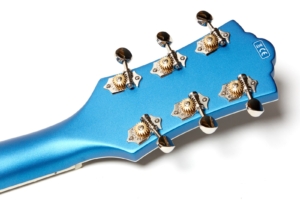 Here’s where I include my standard diatribe about hating the tuners on Newark St. guitars. They’re Grover Sta-Tite 18:1 open gear tuners, so they’re not garbage, and they cost about the same as a set of Rotomatics (at least at retail), but I think they look very out of place on an electric guitar and I detest the tiny little tuning pegs. As always, I’ll say that I get many people reporting that they love them, so feel free to consider this one cranky dude’s opinion and move on. Just don’t come crying to me when the gears are full of schmutz after playing in dive bars for 10 years in the ’70s and ’80s. Wait, what? Medication time? That means it’s time for Jello!
Here’s where I include my standard diatribe about hating the tuners on Newark St. guitars. They’re Grover Sta-Tite 18:1 open gear tuners, so they’re not garbage, and they cost about the same as a set of Rotomatics (at least at retail), but I think they look very out of place on an electric guitar and I detest the tiny little tuning pegs. As always, I’ll say that I get many people reporting that they love them, so feel free to consider this one cranky dude’s opinion and move on. Just don’t come crying to me when the gears are full of schmutz after playing in dive bars for 10 years in the ’70s and ’80s. Wait, what? Medication time? That means it’s time for Jello!
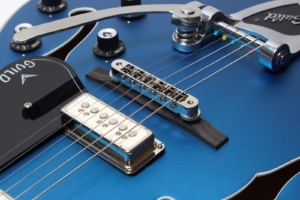 The bridge is pinned to the top so it doesn’t slide around, but I’m not sure pinned is exactly the right term because that bridge is on there for good. Luckily it’s in the right position for intonation so no harm done, though I’d have liked to have replaced the wooden base with a metal one to see about tone changes. That’s a lot of work since those need to be fitted so who am I kidding? My medicated jello is kicking in nicely so I’m just going to move on.
The bridge is pinned to the top so it doesn’t slide around, but I’m not sure pinned is exactly the right term because that bridge is on there for good. Luckily it’s in the right position for intonation so no harm done, though I’d have liked to have replaced the wooden base with a metal one to see about tone changes. That’s a lot of work since those need to be fitted so who am I kidding? My medicated jello is kicking in nicely so I’m just going to move on.
On top of the wooden base sits the Tune-O-Matic bridge which works well enough and was properly intonated from the factory. It is also the same radius as the fretboard which is nice, but I’m not a fan of Tune-O-Matics on Bigsby-equipped guitars, so I’ll likely replace it with a Compton at some point.
The pick guard is the same ugly generic guard from all the other Guild hollow-bodies, and clearly that shows my own personal disdain for the design as there’s nothing functionally wrong with it. I know they’re supposed to invoke the vintage Guilds from the early 1960s or late 1950s, but I think those are ugly, too. Really, though, there’s nothing wrong with the pick guard from a functionality standpoint unless you count the fact that the little spacer under the screw seems to be a bit of plastic tubing and not the felt washer or spacer found on vintage guitars, but that’s the norm on Newark St. Guilds from what I’ve seen.
Sound
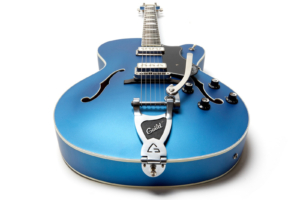 This guitar is visually striking, but how does it sound? Almost exactly the way you hope it does. The pickups do a good job simulating that ’50s DeArmond chime and make this guitar just a whole lot of fun to play.
This guitar is visually striking, but how does it sound? Almost exactly the way you hope it does. The pickups do a good job simulating that ’50s DeArmond chime and make this guitar just a whole lot of fun to play.
I’ve seen a fair number of people asking how these compare to Gretsch Electromatics, and while it’s been a while since I’ve played an Electromatic, I always found them kind of dead sounding when compared with the Japanese (61xx) Gretsches. I don’t get that impression from this guitar, and while it certainly doesn’t ring out acoustically like an X500 or X700, unless you’ve played a high-end American made Guild you’d never notice the difference. I think if I saw one of these in a guitar store and plugged it into a nice amp I’d probably end up taking it home. Hell I bought this one because OMG BLUE! so I’m an easy mark to begin with.
[dropshadowbox align=”right” effect=”raised” width=”” height=”” background_color=”#ffffff” border_width=”1″ border_color=”#dddddd” ]ODS100 Clean
Open Chords #1
Open Chords #2
D-Shape
7th Chords
JCM-800
A-Shape
D-Shape
Rockabilly
Stray Strut End
Sleepwalk
[/dropshadowbox]As usual, for these recordings I used my normal Axe-FX III through the QSC K12 speaker recorded direct into my Mac Pro using Audacity. I recorded using the ODS100 Clean patch, as well as the JCM-800 and one through a setting called Rockabilly Hot Rod which is a replication of a ’65 Fender Deluxe Reverb AB763 amp with some tape echo dialed in to taste. For each recording I cycle through the neck pickup, both pickups, and finally the bridge pickup unless otherwise noted. All knobs on the guitar are on 10 at all times.
I went to great lengths to point out the differences between this guitar and my Westerly X160 Rockabilly guitar, but honestly that’s the guitar that this guitar reminds me of most. Looking at my notes for that guitar I have almost the same comments about this one from the bridge pickup sounding a bit brash to the middle position being absolute magic.
Remember, those are single coil pickups in the guitar, so the middle position is more like the in-between 2+4 positions in a Strat or like the middle position in a Telecaster in that it has much more character to my ears than the middle position in a dual-humbucker guitar.
While I spent probably 80% of my play time with the guitar in that middle position, The bridge and necks positions were absolutely a joy as well. While the bridge pickup can be a bit “bitey”, or harsh, that’s easily dialed out or even taken advantage of if you throw some gain into the mix. The Sleepwalk intro recording was played on the bridge position. The neck pickup is wonderful and round-sounding without getting woofy.
Honestly, as an absolute boutique pickup snob who’s paid more than he’d care to admit for a pair of pickups, I was kind of blown away that these Korean copies of a copy of the original real DeArmond 2000s could sound this good.
Oh, and if you like to see and hear someone who actually knows how to play some Rockabilly on one of these guitars, check out Walter Broes rocking one at The Guitar Bar on YouTube.
Playability
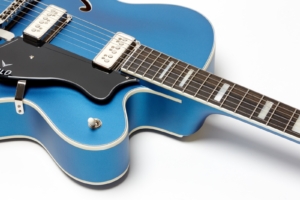 If you’ve ever played a big hollow-body guitar, then you probably know how this one plays just by looking at the pics. If you’re used to thin solid body electric guitars this can be a bit of a learning curve, but if you play an acoustic then not so much, at least from a body positioning point of view. The guitar sits well on the knee and again, behaves much like an acoustic guitar when playing seated with one exception.
If you’ve ever played a big hollow-body guitar, then you probably know how this one plays just by looking at the pics. If you’re used to thin solid body electric guitars this can be a bit of a learning curve, but if you play an acoustic then not so much, at least from a body positioning point of view. The guitar sits well on the knee and again, behaves much like an acoustic guitar when playing seated with one exception.
When standing, I almost immediately found that I didn’t like the position of the pickup selector switch because I couldn’t see it over the girth of the guitar (my own girth notwithstanding). While sitting I had the same problem, and felt like I was reaching around feeling for the selector switch that I couldn’t see. While I have to assume that eventually muscle memory would take over with enough practice, I must also comment that I have many Starfire and X500 guitars with the switch in this position and it never seemed to bother me before. Then again, we are now at week #473 of the 2020 Covid-19 lockdown and I may have eaten more than I’ve exercised by a ratio of probably ∞:0 (Yay Jello!), so girth may be the problem after all.
It’s pretty common for me to take the pick guards off of my guitars because I don’t like the way they thump under my fingers and I can usually play just fine without them, but on this guitar I actually much preferred the guard on. I don’t know if it’s the carve of the top or the neck angle or what, but this is one of the few guitars I own where I actively disliked playing it with the guard off.
Aside from the impact of my recently opulent diet, the guitar responds like a dream and I just enjoy the hell out of playing it when I can fit in some play time between snacks.
Conclusion
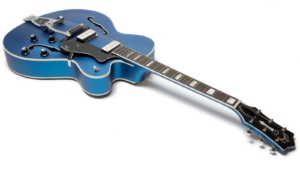 When the Newark St. Guilds first came out I disliked them for no other reason than I hated that import guitars were the new normal for Guild, a long-time US-based guitar company. At first my feelings were validated because there were many quality problems with the early Newark St. guitars, but the new owners (Cordoba Music Group) have done a great thing and now put them all through quality control before shipping them to dealers. That’s actually how I got this guitar because it failed QC and Guild sold it on Ebay as such. As a fun Aside, here’s a pic that the Guild QC Manager posted on Facebook of these X175 guitars in QC. Kudos to Guild for stepping up their game with the Newark St. line. As someone who’s owned many, the effort clearly shows and is appreciated!
When the Newark St. Guilds first came out I disliked them for no other reason than I hated that import guitars were the new normal for Guild, a long-time US-based guitar company. At first my feelings were validated because there were many quality problems with the early Newark St. guitars, but the new owners (Cordoba Music Group) have done a great thing and now put them all through quality control before shipping them to dealers. That’s actually how I got this guitar because it failed QC and Guild sold it on Ebay as such. As a fun Aside, here’s a pic that the Guild QC Manager posted on Facebook of these X175 guitars in QC. Kudos to Guild for stepping up their game with the Newark St. line. As someone who’s owned many, the effort clearly shows and is appreciated!
Let’s sum up the possible negatives:
- The ground wire is too short: Really, nobody cares. This can be resolved by removing the tailpiece and running a new wire if the output jack ever needs to be replaced, and how often does that really happen?
- The finish might not be as robust as other guitars: we won’t really know if that’s a problem until we see these guitars in use for a year or more. To be fair the only place I saw issues was in screw holes, and those are terribly abusive to the finish anyway.
Now let’s list the positives:
- It looks amazing
- It plays great
- It sounds divine
- I liked it so much I added a bonus no-pick-guard pic
If I were to swap any hardware it would be the tuners (which is mostly a “me” problem) and the bridge because a Bigsby deserves a better bridge. Would I swap the pickups? Maybe if I had a pair of originals lying around or felt like buying a set of TV Jones. Would I also be perfectly happy with the guitar as-is? Yeah, I think I would, especially about 20 minutes after Jello Time®.
I’m going to flat out say that this guitar kicks ass. It’s rare for me to have an import guitar end up in my “keep it” pile, but this one absolutely did. Even my 20 year old daughter who thinks that f-holes “look stupid” loves this guitar, and let me tell you, that is some high praise!
I had an X175B that I reviewed back in 2016 and I liked it, but it didn’t really inspire me so I sold it. This guitar is more fun and I am amused at my own impressions because they’re pretty much the same damn guitars, only this one has DeArmond pickups and a killer satin blue finish.
I thoroughly enjoyed this guitar and I have a feeling that you will too.
Donate: PayPal Crypto:
ETH: 0x0AC57f8e0A49dc06Ed4f7926d169342ec4FCd461
Doge: DFWpLqMr6QF67t4wRzvTtNd8UDwjGTQBGs
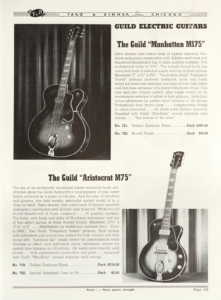
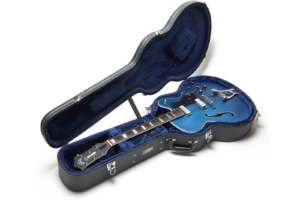

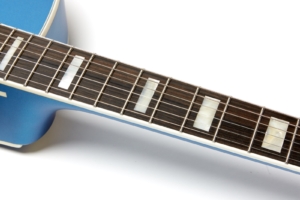
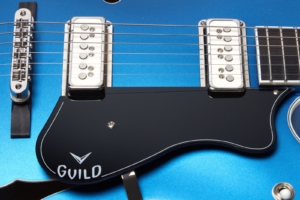
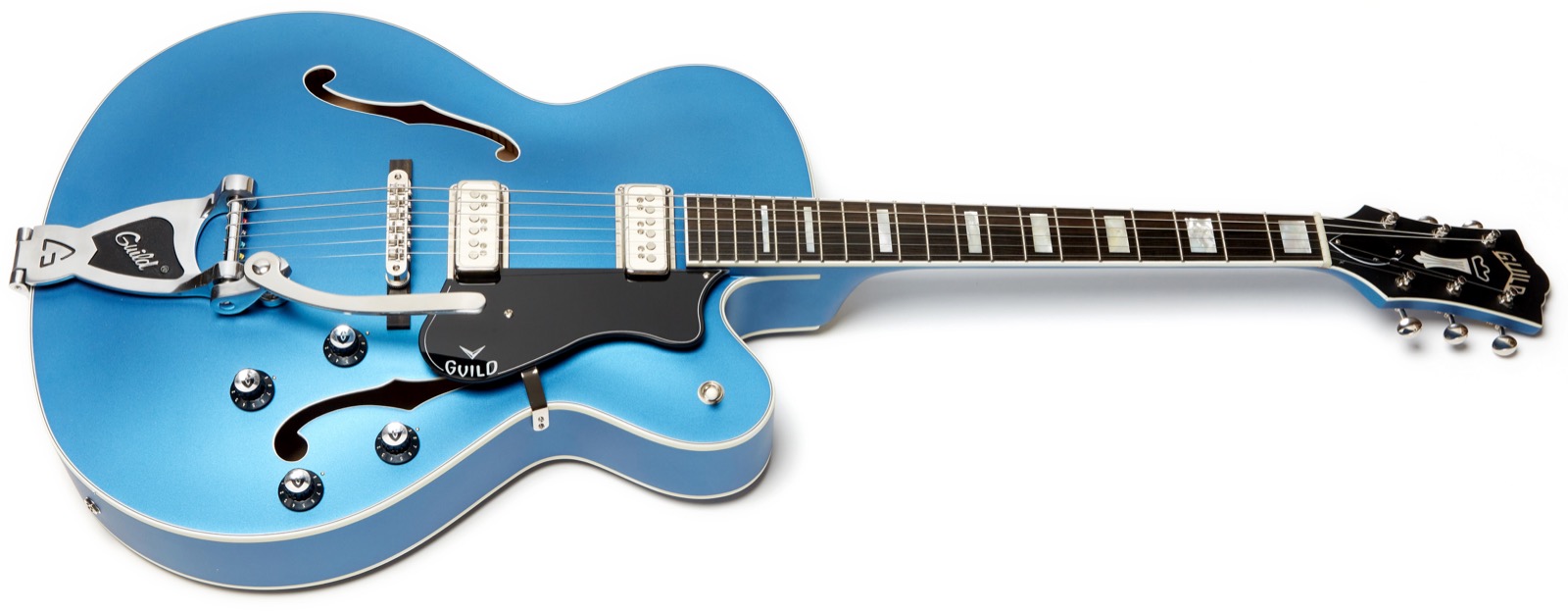
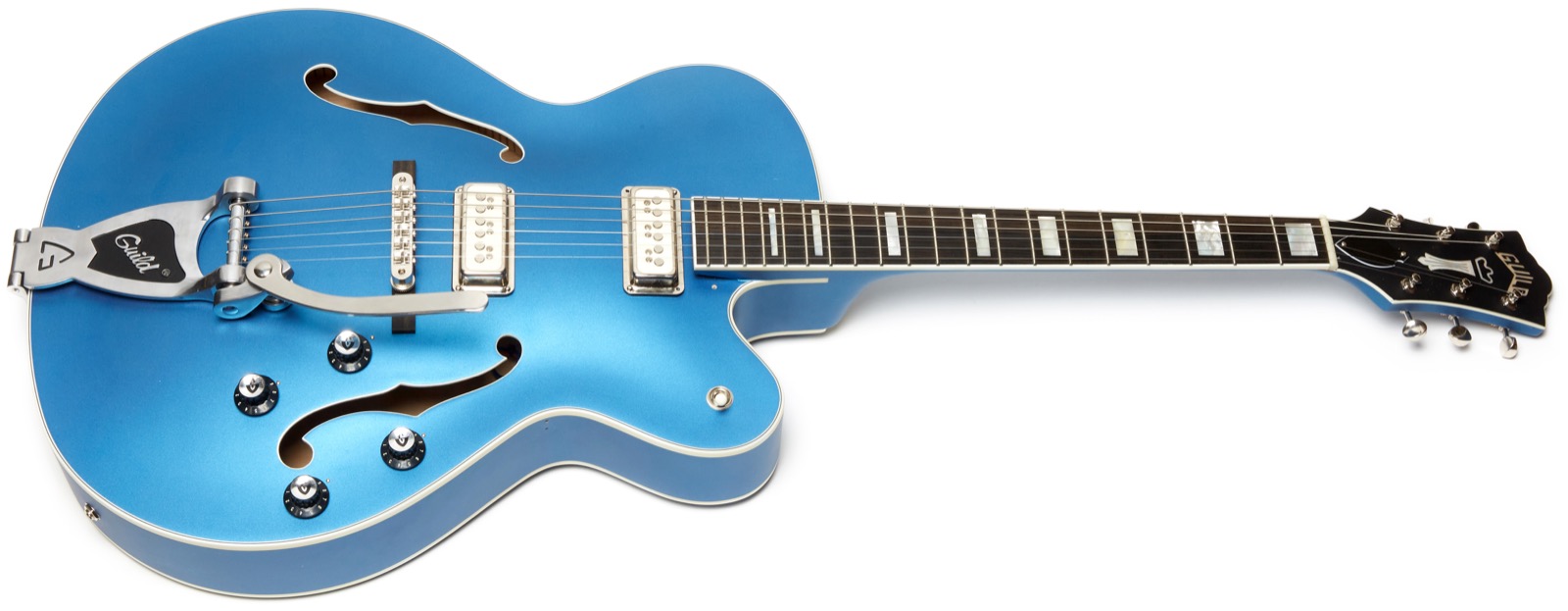
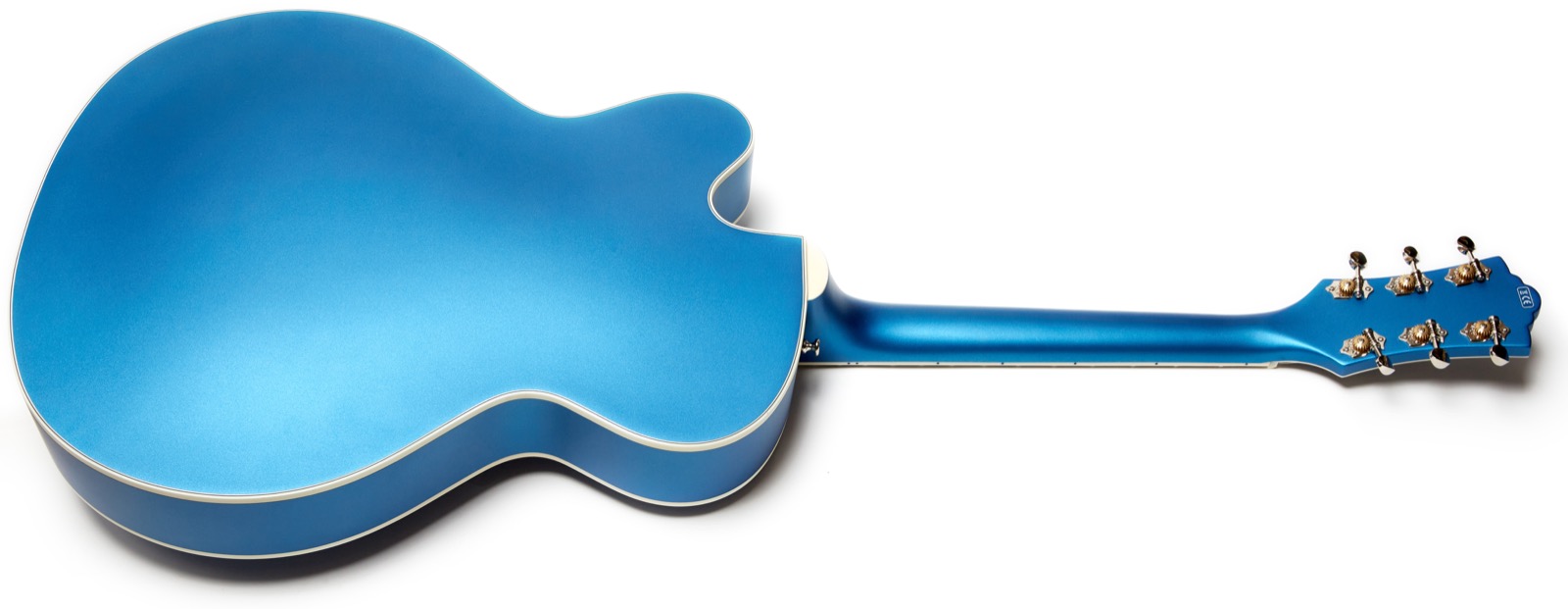
Great review as usual. Anybody who can understand and explain the history/differences between original and the various contemporary DeArmond pu’s deserves a PHD in Research. IMO, the less wooley, lower output variants sound better in big old hollowbody guitars while the higher output DeArmonds (real vintage examples, Duncan repros) sound better in solid (or chambered) body guitars like Gretsch Duo Jets. TVJ T-Armonds I have found to be a real good middle ground as they are not as “wooley” sounding as the Duncans but more fat/punchy or whatever than the reissue DeArmond 2000 from the early 2000s. As far as DeArmonds in vintage Guilds, I’ve actually seen them with my own eyes. Back in the 90’s there was a little mom and pop music shop in Philly (Howard Herbert Music) and the owner, Mr. Herbert had his own personal vintage Guild Starfire III w/ DeArmonds in killer Cadillac Green. He said he had special ordered the guitar from Guild w/ the DeArmonds and a Melita Bridge. Just a beautiful guitar.
Thanks for this great review, it meets my opinion in most details described, even including my opinion to the tuners. I use to play solidbody guitars, and this is my first Hollowbody, so playability was strange in the beginning but meanwhile I love this instrument. Looks great, sounds great. The only issue I have, is the feedback, when playing with the band. Not sure if I will get this problem solved in the end.
Hi Gary,
Great in depth review. Did you happen to measure the output of the new DeArmond pickups? Thanks.
Those “under the hood” photos don’t inspire confidence. Specifically the one showing the neck block and the neck pick up rout. There’s an awful big gap between the neck block and the back. Also, that pickup rout goes nearly clean through the two braces. And what’s going on with that right hand brace? It seems to become tapered and wider than the one on the left.
I own a NS x-175 in the normal spec., and this made me a little queasy. Anyway, I could only have this reaction because of yet another fantastically in depth review by GAD. Many thanks!
Thanks for the great reviews, it’s really fun to share all of your Guild guitar knowledge.
I got me the Guild x-175 Manhattan special and love the look and size of it’s body.
My old ’76 Fender amp was dropping out, – I thought.
But it turned out that the toggle switch has a loose contact when switching to the neck pickup. I have to take care of it, or send it back for repairs. – Not so nice on a new guitar.
When changing the strings, the nut fell from its place. Small thing but not nice either. All in all still a very nice, large and extraordinary guitar that sounds great, but compared to a Korean Gretsch the build quality seems weaker and the price is higher at the same time.
Hi,
I have got same guitar.
Wiring diagram in mine is same as 50s 335, it is different from diagram shown in your review. I checked it. Caps value is same.
Thanks a lot for this review. I just bought mine and it sounds better than my X-175B. I have a pair of Fralins Noiseless P90 wich i wanted to put on it but these “copy of copy of copy” DeArmonds sound very good on this guitar. Maybe I’d better put the (dogear) Fralins on the x-175B instead of selling that one. (And then getting the comments of the Fransz purists, but i don’t mind).
Anyhow i am very glad to have good specialist like you to loook for advice. Thanks a lot for all your work for us!
Hi, cool review. Have you by chance played the D’angelico 175 similar to this guitar?
Thanks